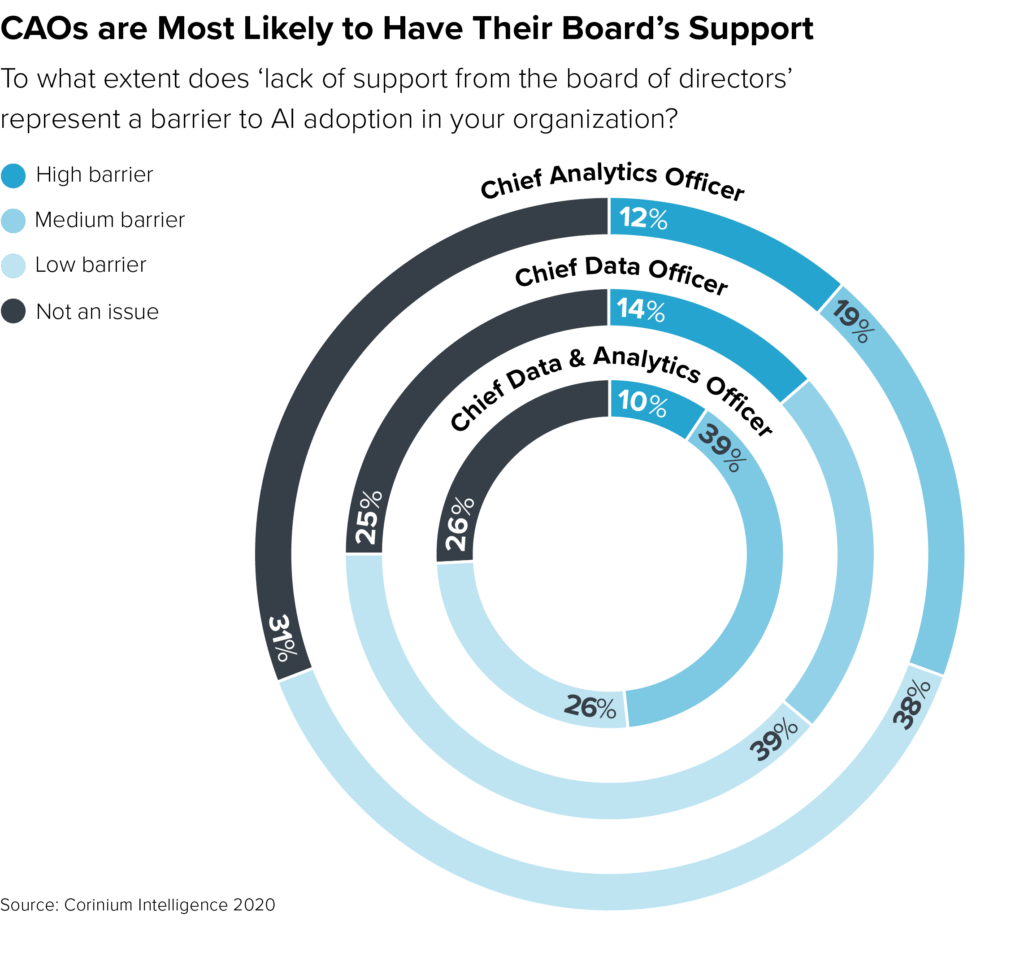Winning the Fight Against AI Fatigue

AI leaders must secure sufficient investment and maintain business-wide commitment to their projects if their organizations’ AI transformations are to come to fruition
AI leaders may be winning the battle to get their boards to support their plans for AI adoption. But our survey of more than 100 C-level data and analytics leaders reveals that translating that support into the funding needed to deliver AI capabilities is proving to be more of a sticking point.
While all respondents agreed that AI’s importance is at least somewhat accepted by their boards, 55% said ‘insufficient funding’ is at least a medium sized barrier to AI adoption in their organizations. Meanwhile, just 51% said they have an open line of communication with their boards.
This lack of communication between the two groups is one possible explanation for the gap between AI support and AI investment.
“The use cases that have been implemented in most of the industry have not proved that [AI is] worth the effort. I’m starting to see some fatigue”
Jose A Murillo, CAO, Banorte
“Some companies are getting tired of AI,” argues Jose A Murillo, CAO at Banorte. “My impression right now is that the use cases that have been implemented in most of the [financial services] industry have not proved that it’s worth the effort. I’m starting to see some fatigue.”
Of course, AI leaders need the board’s ongoing support to sustain the investment and top-down mandate they need to successfully transform their organizations. So, communicating with key stakeholders regularly and preventing ‘AI fatigue’ is a key part of every analytics or AI leader’s job.
To help CAOs and CDOs build support for their AI strategies, we asked our survey respondents how they believe AI will enhance their organizations and how they communicate the value of AI projects to the board.

The Top Four Benefits of Enterprise AI
There are essentially two kinds of AI project – those that seek to improve existing business processes through automation and those that look to fundamentally reimagine how a business operates.
This second approach is more disruptive, and some AI leaders may find that spearheading this kind of business transformation is beyond their remit.
As AXA PPP Healthcare CDAO Nirali Patel notes, the kinds of AI project a data or analytics executive can secure support for will depend on their board’s broader culture and understanding of what AI can do.
“You get the organizations that focus on ‘proofs of concept’ and picking low hanging fruit,” she says. “Then, you have a second type of organization that focuses on scalability.”
“CDAOs in those organizations may appear to be less successful, because they’re not getting value from their investments as quickly as possible,” she adds. “But in the long run, these are the ones to look out for.”
Our research shows that partially automating business processes is the most common goal of AI initiatives, with 80% of survey respondents citing this as a key benefit of AI. Meanwhile, 77% agreed that AI will help them fully automate some processes, 74% said it will help them create better customer engagement and 71% think it will improve their recruitment processes.
“We focused a lot of our AI efforts on understanding the risk profile of our customers. That has helped us to reduce prices in a lot of products, so you have wider access at a lower cost”
Jose A Murillo, CAO, Banorte
Reducing fraud or financial crime and automating or personalizing customer interactions are also popular AI goals, with 70% of respondents citing these as key benefits of using the technology. This will be particularly true for those looking to enhance customer experiences online and expand their digital payment channels in the wake of COVID-19.
“The general view of AI is quite positive from a number of people and they are expecting that it will help automate processes and make our work easier,” says Bart Pietruszka, CDO and Head of Analytics at HSBC. “But it requires quite a lot of funds, investment and time.”
“AI is helping us to build a behavioral mapping of our customers, so that we understand what really moves them,” Murillo adds. “If you understand that a customer is really price sensitive or wants to build wealth, for example, that helps you tailor how you should address them and what offers to deploy.”
Using AI to understand what motivates different customer groups is particularly important today, with people’s circumstances shifting rapidly as a result of COVID-19. But in general, these findings say more about how AI is being used than they do about any intrinsic property of the technology.
The key for executives looking to build a business case for increased AI investment is to understand and quantify the impact a specific use case will have on how their business runs.
Communicating the Value of AI to the Board
The most strategic way to select AI projects that will deliver ROI is to start by identifying a pressing business need.
Once an executive knows how they need to transform their organization, they can evaluate possible ways to achieve that goal and design processes to measure the impact their chosen solution will have once launched.
“My general approach with AI and data science is to start by looking at what the business problem is,” says Patel. “It’s about making sure I’m using the right approach to solve the business problem and meet the business’ needs.”
Our research shows that different metrics are used to measure that impact, depending on how an AI is being used.
‘Impact on customer satisfaction’ and ‘risks mitigated’ were the two most frequently cited measurements for communicating the success of AI initiatives to the board. These were selected by 53% of respondents each.
‘Process or resource usage optimization’, ‘impact on employee satisfaction’ and ‘model accuracy’ were cited by 52%, 45% and 43% of respondents, respectively. This underscores the need to monitor the ongoing efficacy of AI algorithms to show key stakeholders they can be trusted.
Just 38% of our survey respondents use the revenue their AI projects generate as a way to communicate their AI successes to the board. Meanwhile, 37% say the same about ‘savings generated’ and only 29% use ‘impact on employee behavior’ as a key performance indicator.
These findings suggest that data and analytics leaders may find it easier to prioritize or secure buy-in for projects geared towards improving existing processes than they do for those targeting radical business transformation.
Ultimately, communicating the value of AI is about understanding, setting and meeting expectations. It starts with choosing the right projects and agreeing relevant metrics and KPIs to measure their impact with the board.
From there, the key to combatting AI fatigue is hitting those KPIs in the agreed timescales and communicating those wins loudly to key stakeholders.
This is an extract from Building AI-Driven Enterprises in a Disrupted Environment, an exclusive survey of 104 CAOs, CDOs and CDAOs. Download the full research here, now.



